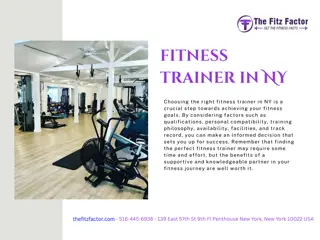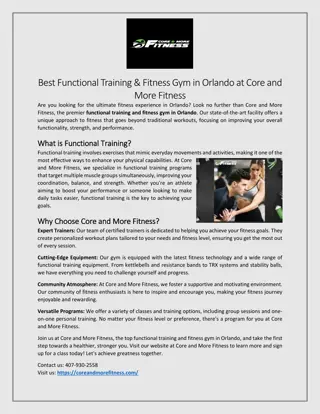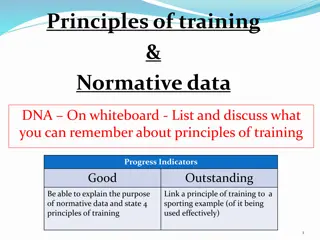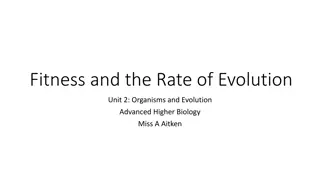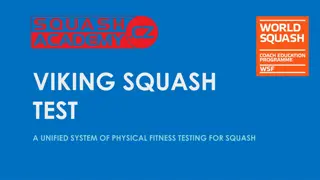Understanding Physical Fitness and its Components
Physical fitness encompasses health-related and skill-related components that contribute to overall well-being. Health-related fitness includes muscular strength, endurance, cardiorespiratory endurance, flexibility, and body composition. On the other hand, skill-related fitness comprises speed, agility, power, balance, coordination, and reaction time. Various factors such as physical activity, age, heredity, nutrition, maturation, and lifestyle choices influence physical fitness. Achieving physical fitness offers numerous benefits including looking and feeling good, enjoying life, mental clarity, work efficiency, disease resistance, and task-specific fitness.
Uploaded on Sep 15, 2024 | 0 Views
Download Presentation

Please find below an Image/Link to download the presentation.
The content on the website is provided AS IS for your information and personal use only. It may not be sold, licensed, or shared on other websites without obtaining consent from the author. Download presentation by click this link. If you encounter any issues during the download, it is possible that the publisher has removed the file from their server.
E N D
Presentation Transcript
FITNESS Dr. Subhas Chandra Nandi Healthy body is a source of achieving the highest goal of life
Definition Physical fitness is the ability of the body s system to function efficiently and effectively. Suitability for a particular job, degree of ability to function Physical fitness is considered a measure of the body's ability to function efficiently and effectively in work and leisure activities, to be healthy, to resist hypokinetic disease, and to meet emergency situation.
Classification of Fitness Health Related Fitness : general fitness is a state of health and well-being Skill Related Fitness : specific fitness is a task-oriented definite based on the ability to perform specific aspects of sports of occupations. 1. 2. Skill related fitness is define as working out with a goal of improving a specific skill.
Components Health Related Fitness Muscular Strength : Maximum amount of force that can be exerted by a muscle of muscle group against a resistance during a single contraction. Muscular Endurance : Ability of a muscle or muscle group to repeat muscular contractions against a force or to sustain a contraction over time. Cardio respiratory Endurance : Maximum functional capacity of the cardio respiratory system to sustain work or physical activity involving large muscle groups over an extended period. Flexibility : Range of movement possible at a joint or joints. Body Composition : Amount of body fat relative to fat-free content expressed as a percentage. 1. 2. 3. 4. 5.
Components Skill Related Fitness Speed : Ability to move the body quickly. Agility : Ability to change direction rapidly with control Power : ability to produce force at a fast speed, a combination of strength and speed usually applied during a short period. Balance : Ability to maintain equilibrium while stationary or moving. Coordination : Ability to execute movements smoothly an efficiently. Reaction Time : Time elapsed between the administration of a stimulus. 1. 2. 3. 4. 5. 6.
Factors that influence Physical Fitness Physical Activity : Age : Heredity: Nutrition : Maturation: Other life style: Rest, Occupation etc. 1. 2. 3. 4. 5. 6.
Benefits of Physical Fitness Looking Good. Feeling Good. Enjoying Life. Sound mind & sound body. Alertness for emergency needed. Efficiency in work and performance. Resistance to disease. Fitness for specific normal task. Efficient functioning of different system of body. Success in games & Sports.
Tests for measured Physical Fitness AAHPER Youth Physical Fitness test. AAHPER Health Related Fitness test. Fleishman Physical fitness test. National Physical Efficiency test. Indiana motor fitness test.
Purpose of Physical Fitness testing Diagnosis Classification Motivation Selection Training Evaluation Development of Norms Efficiency and Economy
Training Components Strength Speed Endurance Flexibility Co-ordinative Ability
Strength : Strength is the ability to overcome resistance or to act against resisitance Types of Strength Maximum Strength : It is the ability to overcome or to act against maximal resistance. Weight lifting, take off in jump, throws, start and acceleration phase in sprints etc. 1.
Explosive Strength : It is the ability to overcome resistance with high speed. 2. strength can be further sub-divided into Start strength Strength speed(power) Speed strength. Start strength : Start strength is the ability to develop maximal muscle force during the starting phase of the movement e.g. sprint start, weight lifting etc. Strength speed : strength speed is the ability to overcome heavy resistances with high speed e.g., throws, jumps etc. Speed strength : speed strength is the ability to overcome lower resistances with high speed e.g., team games, combat sports I. II. III. I. II. III. Strength Endurance : It is the ability to overcome resistance or to act against resistance under conditions of fatigue. e.g. in combat sports, long duration events, pole vault, road cycling etc. 3.
Factors Determining Strength Muscle Cross Section : Size of Muscle Muscle Fibre Spectrum : White fiberes and Red fibers Co-ordination : Inter muscular & intra muscular co- ordination. Energy Supply: Body Weight: Psychic Factor:
How you will developed strength Physical Exercise: Types of muscular Contraction : Static muscle contraction, Dynamic Muscle Contraction & Combination. Method of Strength training: Dynamic concentric method, Dynamic eccentric method, Iso-Kinetic method, Static method Organisation of strength training: station training, set training, circuit training, contrast method & decrease resistance and constant repetitions.
Speed: Ability to move the body quickly. Factors Determining Speed Mobility of the Nervous system Explosive Strength Technique Bio-chemical Reserves and Metabolic power Flexibility Psychic Factor
Components of speed Reaction Ability Acceleration Ability Movement Speed 1. 2. 3. 4. Locomotion Ability Speed Endurance 5.
Endurance :"Endurance is the ability to do sports movements, with the desired quality and speed, under cinditions of fatigue." Types of Endurance Types of Endurance According to nature of activity According to duration of activity Speed Endurance Short time Endurance Middle time Endurance 1. Basic Endurance General Endurance Specific Endurance 1. 2. 2. 3. 3. 4. Long time Endurance
Factors determining endurance Aerobic Capacity : oxygen intake, oxygen transport, oxygen uptake, energy reserves Anaerobic Capacity : phosphogen store, buffer capacity, lactic acid tolerance, aerobic capacity Movement Economy: Psychic Factors:
How you will develop endurance Continuous method: Interval method: Repetition method: Competition method:
Flexibility: Range of movement possible at a joint or joints Type of Flexibility Active Flexibility Passive Flexibility
Factors determining Flexibility Anatomical structure of the joint Ligaments of the joint. Stretch ability of muscles Co-ordination Muscle bulk : Size of muscle Strength
How you will develop flexibility Ballistic method Slow Stretch and hold method Post iso-metric stretch




